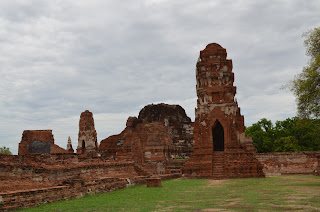Our first stop on our day of touring was the Bang Pa-In Palace, also known as the Summer Palace. It was originally built by Ayutthayan King Prasat in 1632 but abandoned 1767 and later restored by King Mongkut in the 1850s. The grounds and builds are every beautiful with European-Style in 1872-1889.
Our next stop was Wat Yai Chai Mongkol where the large chedi built in 1952 can be seen from great distances. The chedi was built by one of Ayutthaya's greatest Kings, Nareusan the Great, to commemorate a victory over the Burmese Army won in that same year. The Temple was established earlier in 1357 as a place for Monks to meditate. The Temple is still functioning today.
Our next site of exploration was Wat Maha That. This is one of the oldest and most significant temples in Thailand. Built in the 13th century it served as an important religious center until it was reduced to ruins in 1767 by the Burmese Army. It is here that a famous iconic image remains of a Buddha head entwined within the roots of a tree. Nobody knows for certain how the head became entwined in the roots other than the explanation it occurred during the abandonment following the invasion.
Next we headed to Wat Phra Si Sanphet. Situated in the Royal Palace grounds it is the Royal Monastery and therefore no monk is allowed to reside. The Temple served to conduct ceremonies within the Royal Court.
Next destination for this trip was to Wat Chaiwatthanaram. This Temple was built in 1630 by King Prasat to honor his mother. This features the architectural style influenced by Angkor Wat in Cambodia.
Lastly we stopped at Wat Na Phra Meru. Built in the mid-15th century it is one of the largest in the city.
We have been fortunate enough to travel all over the world, however we take ever opportunity we get to explore the country where we live. We are loving Thailand more and more as we come to the close of our two year assignment. So much to see and the history is amazing! Great trip!



























No comments:
Post a Comment